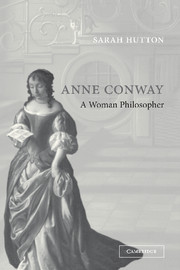Book contents
- Frontmatter
- Contents
- Acknowledgements
- Introduction
- 1 Anne Finch, Viscountess Conway
- 2 A philosophical education
- 3 Religion and Anne Conway
- 4 Anne Conway and Henry More
- 5 John Finch, Thomas Hobbes and Margaret Cavendish
- 6 Experimental physick: Boyle, Greatrakes, Stubbe
- 7 Physic and philosophy: Van Helmont, father and son
- 8 Kabbalistical dialogues
- 9 Quakerism and George Keith
- 10 Last years
- 11 Legacy
- Bibliography
- Index
1 - Anne Finch, Viscountess Conway
Published online by Cambridge University Press: 22 September 2009
- Frontmatter
- Contents
- Acknowledgements
- Introduction
- 1 Anne Finch, Viscountess Conway
- 2 A philosophical education
- 3 Religion and Anne Conway
- 4 Anne Conway and Henry More
- 5 John Finch, Thomas Hobbes and Margaret Cavendish
- 6 Experimental physick: Boyle, Greatrakes, Stubbe
- 7 Physic and philosophy: Van Helmont, father and son
- 8 Kabbalistical dialogues
- 9 Quakerism and George Keith
- 10 Last years
- 11 Legacy
- Bibliography
- Index
Summary
‘Honoratissima atque illustrissima Domina’
Anne Conway was born on 14 December 1631. She was the posthumous daughter of Sir Heneage Finch, younger son of Sir Moyle Finch, and Elizabeth Bennett, the daughter of William Cradock of Whickambrook in Staffordshire and widow of Sir John Bennett, a wealthy London merchant. Anne's parents were married on 16 April 1629 at St Dunstan's in the West in the City of London. Her father was himself a widower, his first wife, Frances Bell, having died on 11 April 1627. But he did not live long after his second marriage: he died on 5 December 1630, less than two weeks before the birth of his youngest daughter, Anne. When she married Sir Heneage Finch, Elizabeth Bennett already had at least one child, Simon Bennett, from her previous marriage. By her marriage to Sir Heneage, she became stepmother to the four surviving children from his first marriage: Heneage, Frances, Elizabeth and John. In her second marriage she had two children, both daughters, Francis and Anne. The future Lady Conway, then, was the youngest child of a large family of at least seven children raised in a fatherless household.
The Finch–Bennett match ensured their children belonged to a network of prosperous families, well on the road to social advancement: with roots in the City of London, a judicious combination of career and marriage alliances was to bring them connections in the law, government and the aristocracy.
- Type
- Chapter
- Information
- Anne ConwayA Woman Philosopher, pp. 14 - 35Publisher: Cambridge University PressPrint publication year: 2004

